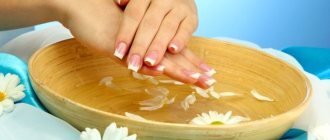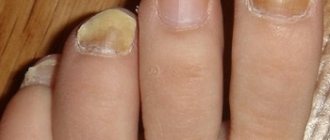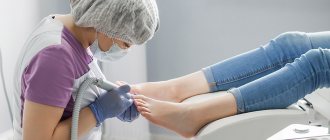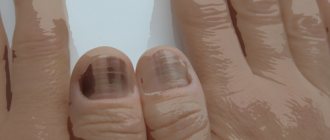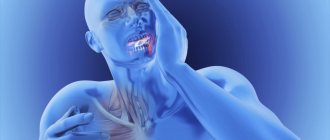Onychogryphosis (ICD code 10 L 60.2) is a dystrophic change in the nail plate, in which it thickens and becomes shaped like a bird’s claw. The name of the disease comes from the fairy-tale griffin bird with the body of a lion and the head of an eagle, because such nails are similar to its claws.
The deformity usually occurs only in older people and most often affects the nails of the big toes. Onychogryphosis worsens the quality of life of people, causing pain and discomfort when walking or other stress on the feet. To correct the appearance of the nails, depending on the severity of the condition, conservative or surgical treatment options are used.
What causes?
Unlike other types of nail plate dystrophy, claw deformity is rare. It mainly affects only the toenails. Onychogryphosis is almost never found on the hands. The disease is provoked by injuries, malnutrition of the plate, infections, and constant irritation of the nail.
In case of injury, deformation occurs because the resulting hematoma and swelling compress the tissues of the nail bed, disrupt blood flow, and slow down metabolic processes. This leads to the accumulation of harmful metabolic products in cells and increased keratin synthesis. As a result, the keratinization zone grows, the keratin scales do not have time to peel off and overlap each other. The connection between the plate and the bed is disrupted, which leads to thickening.
With an infectious lesion, onychogryphosis provokes chronic inflammation, accumulation of purulent formations, blood and lymph in the soft tissues.
Another mechanism is associated with impaired nutrition of the tissues of the nail apparatus. For this reason, it is so common among older people, especially those over 70 years of age. The fact is that with age, physiological aging of the skin and its appendages occurs. Due to chronic diseases, blood vessels narrow, which means the supply of oxygen and nutrients to the fingers decreases. The nail matrix becomes thinner, loses moisture and fats. All this provokes trophic changes, disruption of the structure and chemical composition of the plate, and causes increased hyperkeratosis.
Considering the mechanisms listed above, risk factors include:
- hammertoe deformity, flat feet;
- impaired blood supply to the periungual tissues due to chronic vascular pathologies (vasculitis, atherosclerosis, diabetes mellitus, varicose veins);
- injuries, frostbite, burns;
- fungal infection (onychomycosis);
- dysfunction of the thyroid gland;
- severe infections (syphilis, tuberculosis);
- inflammation of peripheral nerves;
- ingrown nail;
- lack of nutrients.
In addition to these reasons, onychogryphosis is also caused by external factors. For example, it occurs in athletes whose fingers are exposed to the same type of stress.
Also, claw-shaped deformation occurs as a result of:
- ill-fitting shoes that squeeze your toes;
- careless pedicure;
- using low-quality varnishes or acetone-based removers;
- contact with aggressive household chemicals.
Bird's claw deformity sometimes develops as a complication of the autoimmune pathology of psoriasis, in which the body produces an excess of keratinocytes and the skin becomes covered with red, dry, scaly patches. In 50% of cases it affects not only the skin, but also the nails.
Psoriatic onychogryphosis is usually preceded by other characteristic changes:
- numerous pinpoint depressions on the nail;
- detaching the plate from the bed;
- inflammation of the nail folds.
The disease can be not only acquired, but also congenital, when its appearance is associated with a gene mutation. In the congenital form, all fingers and toes are affected.
Types of onychodystrophy
Nail dystrophy can be congenital, arising against the background of burdened heredity or gene abnormalities, and acquired. The first group includes:
- anonychia (complete or partial absence of nails);
- platonychia (flattening of the nail plate);
- koilonychia (spoon-shaped depression in the central part of the nail);
- onychomadesis (separation of the plate from the bed on the side of the cuticle);
- micronychia (abnormally short nail plate);
- Hippocratic fingers (flask-shaped thickening of the terminal phalanges of the fingers with convex nail plates in the shape of watch glasses)
Acquired trophic disorders:
- onycholysis (detachment of the entire nail from the bed);
- onychoschisis (transverse splitting of the anterior (free) edge of the nail plate);
- onychogryphosis (thickening and curvature, like a bird's claw);
- onychorrhexis (a condition in which the nail cracks along the plate);
- onychauxis (loss of transparency, darkening, even blackening);
- Keller's canaliform dystrophy (formation of a longitudinal groove with branches “herringbone symptom”);
- Beau-Reilly lines (arched transverse grooves, the so-called “ribbed nail”);
- thimble syndrome (presence of small pinpoint indentations on the plate, more common in psoriasis);
- scleronychia (hypertrophy, thickening, compaction);
- hapalonychia (softening);
- trachyonychia (roughness, dullness);
- dyschromia (pointed, stripe-like or total color changes).
Symptoms and stages
Depending on the severity of the disease, two stages are distinguished:
- Early. The nail thickens, becomes cloudy, and acquires a yellow, gray or brown tint. Its surface loses its smoothness, becomes bumpy and rough. The plate is slightly curved and rises above the bed;
- Late. The nail becomes twisted and its structure changes. Multiple longitudinal and transverse stripes appear. The shape becomes convex, already clearly reminiscent of a “bird’s claw”.
Look at the photo to see what nails look like with onychogryphosis.
Early signs of the disease include discomfort in the nail plate area. For example, pain, itching, discomfort when putting on shoes or walking. These symptoms are felt especially strongly on the thumb, and intensify when pressed or squeezed.
Then the texture and direction of nail growth are distorted. It becomes convex, first grows upward, and then extends beyond the nail bed and curls up. The shape of the affected nail resembles a spiral, screw, horn, or is simply bent down. When rolled, its length reaches 5–6 cm or more.
Often changes affect not only the nail, but also the surrounding soft tissue. Bedsores and inflammatory processes are noted.
Who should I turn to for help?
If you suspect onychogryphosis, you should go to a dermatologist or podologist. The specialist will carefully examine the affected fingers. He will ask about nail care, lifestyle, chronic diseases, and recent injuries to the fingers. Then he will make a diagnosis, find out why the deformation occurred, and prescribe adequate therapy.
Unfortunately, in the early stages the disease is difficult to diagnose. The present hypertrophy of the plate is characteristic of various nail disorders, so you cannot do without help.
To clarify the cause of onychogryphosis, additional examination and consultation with specialized specialists (endocrinologist, vascular surgeon, immunologist) are recommended.
Prescribed:
- test for syphilis (Wassermann reaction);
- determination of blood glucose levels;
- dermatoscopy (examination using a dermatoscope at 10x magnification).
If fungus or other infections are suspected, a scraping is taken from the affected nail for analysis under a microscope.
How to treat?
Treatment of nails for onychogryphosis depends on the severity of the condition and the cause of the disease.
His tasks:
- eliminate the provoking factor;
- reduce the thickness of the nail, adjust the shape, improve the appearance;
- remove painful symptoms, inflammatory processes;
- restore motor activity.
To correct the shape, medical hardware pedicure and keratolytics are used, which help soften the roughened plate and facilitate the reduction of its thickness.
To treat onychogryphosis, an integrated approach is needed, including drug therapy, hardware treatment, physiotherapy, massage, therapeutic baths, strengthening the immune system, and improving local blood circulation.
If a fungal infection is detected, the affected areas of the nail plate are cleaned and fungicidal medications are prescribed.
Also, for onychogryphosis, the following drugs can be prescribed:
- Antibiotic ointments to relieve bacterial complications;
- Vitamin and mineral complexes containing selenium, calcium, silicon, zinc, retinol, tocopherol. Help speed up recovery processes, replenish nutritional deficiencies, improve immunity;
- Agents that relieve inflammation.
If onychogryphosis is associated with other internal diseases, the person is referred to a specialist who treats them.
In advanced cases, if there is no improvement from conservative therapy, surgical treatment is resorted to. It consists of cleaning the hard stratum corneum and removing the affected areas of the plate. If there is no result, complete removal of the nail is recommended.
For the surgical treatment of claw-shaped curvature of the nails or onychogryphosis, the following is used:
- Removing the affected nail with a scalpel. The method is traumatic, requires sutures and difficult rehabilitation. The pain persists for a long time, which makes it difficult to move and confidently support the leg;
- Phenolization or cauterization of the growth zone with phenol. After this procedure, the nail does not grow back. The method is used for hereditary forms of the disease when it is impossible to eliminate the cause;
- Radio wave removal. The nail is removed with a radio knife using the Surgitron installation. The method does not injure healthy tissue, the treated area heals quickly;
- Laser removal, when the affected plate is evaporated by a laser beam. The recovery period lasts several days.
Is it possible to cure onychogryphosis of nails yourself?
Self-treatment at home is more likely to lead to infectious complications and injuries than to good results.
There are different recommendations on the Internet:
- steaming in soda solutions;
- baths with medicinal herbs;
- removing damaged plates with patches with salicylic acid or urea;
- dressings with kombucha, aloe leaves, celandine juice;
- compresses with essential oil of tea tree, lavender, fir oil.
Treatment of onychogryphosis at home is ineffective. Before you decide to use such methods, you need to think about it. Will you harm yourself? Do you know why your nail has changed so much? Are you sure that such treatment is not contraindicated for you? At best, you will not get results, and at worst, you will get an infection, cause irritation, inflammation, tear off part of the nail, and get injured.
Claw-shaped deformity is a serious disorder, so medical attention and care are necessary. Before attempting to treat nail onychogryphosis with folk remedies, consult your doctor.
Medicines used
In the treatment of onychorrhexis, the most important thing is to eliminate the cause. After this, you can begin treatment for this disease. In this case, drugs are used to improve blood microcirculation and to strengthen the walls of blood vessels, physiotherapy and massage. It is necessary to prescribe vitamins and minerals in accordance with the patient’s age, take saturated fatty acids and amino acids. It is these substances that help strengthen nails and eliminate their delamination. A good effect is also obtained by taking edible gelatin, but before treatment you must consult a specialist. It is mandatory to consult a psychotherapist and prescribe sedatives.
Baths with sea salt and essential oil help to cope with nail damage due to this pathology. If necessary, ozokerite paraffin and therapeutic mud are used.
Complications
Onychogryphosis is not only an aesthetic problem. It worsens the quality of life, leads to complications, and causes difficulties in caring for nails and choosing shoes. Due to the inability to put on shoes and severe pain that occurs when walking, the disease limits a person’s physical activity.
With claw-shaped deformity, infectious complications are quite common. The wrong direction of growth of the plate leads to ingrown nails and the development of a purulent inflammatory process.
Diagnostics
The primary diagnostic complex includes:
- dermatoscopy;
- scraping microscopy;
- mycological culture (to exclude the fungal nature of the disease).
In parallel, differential diagnosis is carried out with the exception of such a disease as “ribbed nail”, which occurs due to a violation of the general metabolism or the functioning of individual systems and organs.
In this situation, our podologists recommend consultation with related specialists who are competent in correcting the underlying pathology.
How to warn?
Unlike the congenital form of the disease, the acquired form can be prevented. After all, deformation is often provoked by sloppiness, improper care, and inattentive selection of shoes.
What to do to reduce risks?
- be careful to prevent accidental injury;
- carefully choose shoes so that they fit in size and do not squeeze the foot anywhere;
- wear corrective orthopedic insoles, orthoses, shoes if you have flat feet or toe deformities (valgus, varus, hammertoe);
- take care of the prevention of fungal infections;
- control the course of chronic diseases that can lead to disruption of the supply of nutrients and oxygen to the tissues of the nail apparatus;
- undergo regular examinations by a podologist, perform hardware medical pedicures for early detection of the disease;
- provide adequate nutrition;
- trim toenails only at right angles and not in a semicircle;
- carefully perform manicure and pedicure.
In the case of a congenital form, constant observation and treatment of the affected nails by a specialist are required. This helps improve their appearance, avoid complications, and minimize discomfort and pain.
Remember that any problems with nails and feet are best dealt with at an early stage. This will give you a better chance of quick, successful treatment. If you notice any irregularities or strange changes, immediately go to the podiatrist. Timely contact with a specialist for onychogryphosis will allow you to preserve the nail plates and avoid their complete removal.
0 0
Treatment with folk remedies
Traditional methods are useful only in combination with classical therapeutic measures:
- Lemon juice and oil. A tablespoon of heated olive or sunflower oil is mixed with a teaspoon of lemon juice. The resulting suspension is rubbed into the damaged nail plate 2 times a week for 1-2 months.
- Red pepper. Add 10 drops of water and 2 grams of red pepper powder to a teaspoon of nourishing hand cream. Apply the mixture to your nails after a water bath for 20 minutes. Use once a month for six months.
- Beeswax. Melt a bar of beeswax, add a chicken egg yolk and 10 drops of peach oil. Dip your fingertips and nails into the solution and slowly pull out so that the wax evenly covers your fingers. Keep the wax caps on for half an hour. The procedure is carried out daily for a month.
